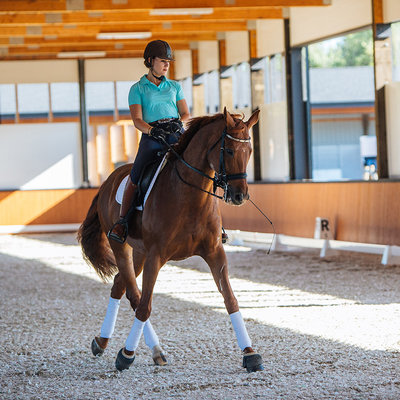
Inevitably when I come home from a horse show and my friends ask me how I fared, my response starts off with, “Well, my dressage score sucked.” Or I tell them, “I swear that judge hates my horse.” (It’s more probable my high-strung horse Cairo hates dressage, a sport of athleticism and endless patience. She sorely lacks the latter.)
Dressage for the uninitiated is what Stephen Colbert called “competitive horse prancing” when 2012 presidential hopeful Mitt Romney’s wife’s horse Rafalca did it in the London Olympics. It’s sort of like figure skating — from snazzy outfits to the subjective judging — in that it combines athletic skill with artistry. In dressage, however, you have the added factor that one of the athletes weighs 1,000 pounds and whinnies.
Horse and rider execute patterns and movements from simple circles at the lower levels to complicated moves at the upper levels like majestically trotting in place (piaffe) or pirouettes that create the vision the horse is dancing.
To complete the dancing image, the horses in competition sport elegantly braided manes and tails, and riders wear suit jackets, gloves, white breeches and, in some competitions, top hats and tails — though these days many riders have doffed their traditional top hat in favor of a safety helmet.
According to Leslie Chapman, a Creswell-based dressage trainer who rides her horse Quantro (aka Q) at the grand prix, the highest level, “Dressage is art and science with luck sprinkled in.” She says dressage is “steeped in history dating back to the Greek writings of Xenophon and is the foundation for nearly all equestrian disciplines.”
Chapman trains riders at a variety of levels, from local kids at practice shows to coaching a student at the U.S. Dressage Finals last November. She says that the sport is “the harmonizing of two athletes” to one end goal. She works with a cross section of types of horses, from expensive European warmbloods to ex-racehorses to sassy beasts like mine, and she says “every horse is unique, too. They all have the ability to learn something from dressage — balance, cadence and steadiness.”
Ask dressage riders why they love the sport and the answers make them sound like yoga practitioners — they talk about the movement, the breathing, the balance and the use of the body.
“For me it’s about the flow of energy that happens between a soft, supple, in-the-moment rider and a round, relaxed, content horse,” says Ann Hettick, a teacher at South Eugene High School who rides a Canadian horse named Bella with dressage trainer Anna Rae-Sue Keenan. “It’s solid. It’s centered. It’s freedom.”
Talk to a parent of a kid who rides dressage or the long-suffering partner of a dressage aficionado and they will tell you watching dressage is like watching cement set: horses walking, trotting and cantering in an arena with the spectators utterly silent among the footfalls of the horse.
Sometimes, duos like Cairo and I make it more interesting — Cairo jazzed up one of our 20-meter circles with a little rear and some wild-eyed threats of further equine violence at our last show that were good for some gasps from the spectators.
Chapman’s student, Liva St. Cyr, who rides and competes a chestnut gelding named Flash, says she enjoys “the perfectionism of it and feeling those moments where you finally get it right.” Noting that indeed the sport isn’t always as exciting to those on the ground, she says, “Onlookers, friends and family can’t tell what just happened, but you feel it.”
Dressage lovers are thrilled that U.S. riders clinched the team gold medal on July 12 at the 2015 Pan Am Games in Toronto. To find out more about dressage, go to the U.S. Dressage Federation at wkly.ws/21l or check out the local Twin Rivers chapter of the Oregon Dressage Society at wkly.ws/21m.